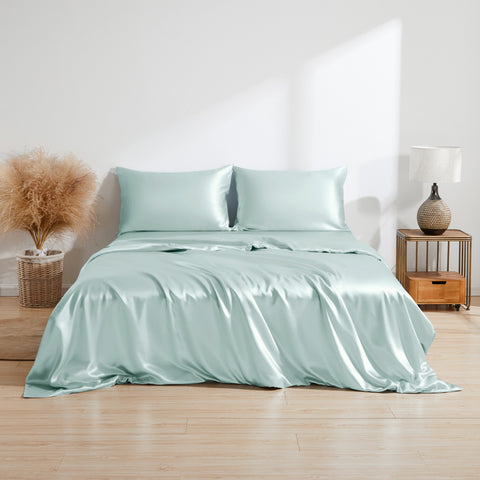Silk sheets are not so common and are often hidden away in the cotton bedding products sections of your local store. So why are silk sheets mysterious? How can we pick out a high-quality yet comfortable silk bedding?
Here are 10 myths about silk sheets that you should know before making the decision to purchase them.
MYTH #1: Silk sheets are slippery.
While it is true that silk sheets have less friction than your run-of-the-mill cotton sheets, you are not likely to slip off a bed with silk sheets. This myth is spread because silk sheets are often mistaken for 'look a like' satin 'silks' which are made from polyester. These polyester satin 'silks' can be very slippery.
MYTH #2: Silk sheets require dry cleaning.
Good quality silk sheets can be machine washed on a gentle cycle in cold water and do not require dry cleaning, as long as a silk-friendly detergent is used. As you continue to wash silk sheets, they will lose some of their luster, but they will actually become softer after a few washes. In fact, many people find that they like their silk sheets even more after they have been washed a few times.
MYTH #3: Silk sheets will shrink when washed.
High-quality silk sheets that are cared for correctly will not shrink significantly when washed. If your sheets fit your bed correctly before washing, they will still fit the same bed after washing.
MYTH #4: All silk sheets are the same.
There are a variety of silk sheets on the market today, and it can sometimes be difficult to compare sheets because many manufacturers do not provide all the information needed to make an informed decision.
For starters, the momme weight of the silk sheet can range from 6-30mm. This is used as the main metric to measure the quality of the silk (similar to thread count, which is often used with other textiles, like cotton). Ideal weights for silk sheets fall between 16-22mm with many believing 19mm provides the best balance of strength, look and affordability. If a manufacturer does not tell you the momme weight of their sheets, you should look elsewhere.
In addition to momme weight, there are also different types of silk used in silk sheets. These included Charmeuse Silk, Tussah Silk, and Habotai Silk (often called China Silk). Charmeuse Silk and Habotai Silk are produced from the mulberry silk worm breed in captivity. They differ in feel and luster, with Charmeuse silk having a high luster and less friction, and Habotai Silk having a sandy matte finish. Tussah silk is produced from wild silk worms and is generally considered to be of lower quality. Tussah Silk usually has visual impurities from the fabric's finish and will often have knots in the texture due to broken silk fibers.
MYTH #5: Silk sheets will catch my skin.
This is another case of mistaken identity. Satin 'silk' from polyester (a man-made fabric) is very slippery and yet will catch your skin if your hands are very rough and callused. However, 100% pure silk sheets will not catch your skin the way polyester 'silk' does. It is softer in texture and very smooth to the touch.
MYTH #6: Silk sheets are expensive.
It is true that silk is one of the more expensive fabrics on the market, however, the benefits of sleeping on silk sheets make it more of an investment in your long-term health and well being. When viewed as a long-term investment, silk sheets are actually rather affordable; the benefits will last over many years.
MYTH #7: Silk sheets are chemically processed.
While it is possible that some cheaper silk sheets may be bleached, good quality silk sheets, such as THXSilk sheets, are naturally white and do not require bleaching. In addition, silk production does not require pesticides or herbicides often found in some textiles. This is because mulberry silk is made from silkworms raised in captivity in temperature-controlled environments that are free from predators. This is one reason silk is a better choice for those hoping to reduce their chemical exposure from bedding.
MYTH #8: Silk sheets are a modern-day invention.
In fact, silk from the mulberry silk worm in China has been cultivated for over 5,000 years. Initially, silk was so expensive and difficult to produce, only the emperors and their closest family members were able to afford it. Eventually, silk production increased and became a major currency in trade between the East and West, creating what is referred to as the Silk Road. Today, silk is much more affordable than in the past and is now within the reach of many.
MYTH #9: Silk is inexpensive to produce.
There is good reason silk costs a little more than your average set of sheets. Silk production requires thousands of silk cocoons to be unrivaled and spun into silk thread or yarn. Between 3,000 - 5,000 cocoons are used, on average, to produce one pound of silk. To produce a single THXSilk Fitted King Sheet requires around 5,000 cocoons!
MYTH #10: Silk is a delicate fabric and won’t last long.
While silk does require some care, it is a strong fabric for its weight. In fact, its strength-to-weight ratio made it the primary fabric used in parachutes before the invention of nylon. This delicacy myth is propagated because silk is often used in lingerie or woman’s dresses in a lightweight, such as 6, 8, or 10 mm. A heavier weight quality silk around 19mm or more will give you many years of use with proper care.






